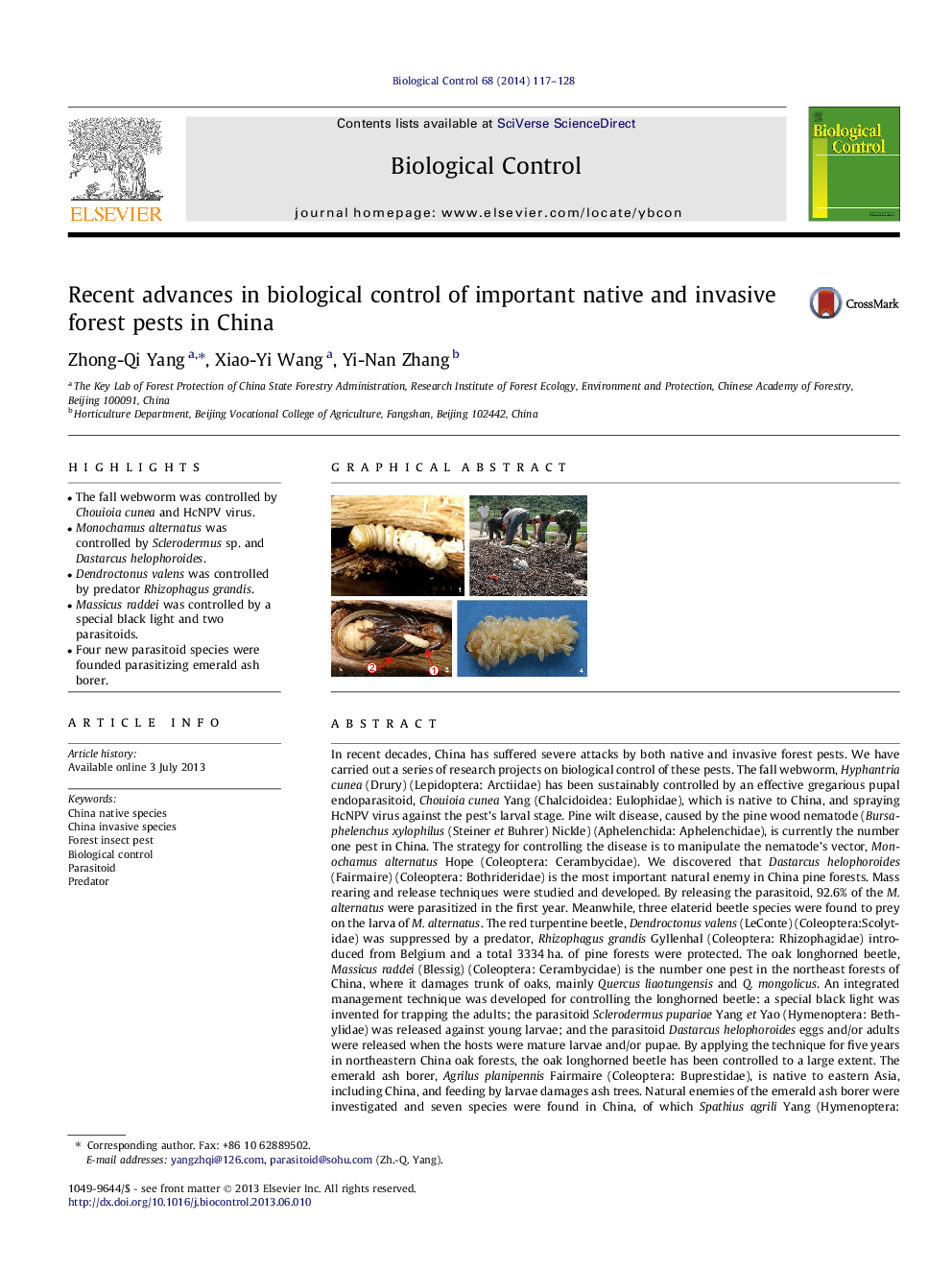| کد مقاله | کد نشریه | سال انتشار | مقاله انگلیسی | نسخه تمام متن |
|---|---|---|---|---|
| 4503966 | 1624266 | 2014 | 12 صفحه PDF | دانلود رایگان |
• The fall webworm was controlled by Chouioia cunea and HcNPV virus.
• Monochamus alternatus was controlled by Sclerodermus sp. and Dastarcus helophoroides.
• Dendroctonus valens was controlled by predator Rhizophagus grandis.
• Massicus raddei was controlled by a special black light and two parasitoids.
• Four new parasitoid species were founded parasitizing emerald ash borer.
In recent decades, China has suffered severe attacks by both native and invasive forest pests. We have carried out a series of research projects on biological control of these pests. The fall webworm, Hyphantria cunea (Drury) (Lepidoptera: Arctiidae) has been sustainably controlled by an effective gregarious pupal endoparasitoid, Chouioia cunea Yang (Chalcidoidea: Eulophidae), which is native to China, and spraying HcNPV virus against the pest’s larval stage. Pine wilt disease, caused by the pine wood nematode (Bursaphelenchus xylophilus (Steiner et Buhrer) Nickle) (Aphelenchida: Aphelenchidae), is currently the number one pest in China. The strategy for controlling the disease is to manipulate the nematode’s vector, Monochamus alternatus Hope (Coleoptera: Cerambycidae). We discovered that Dastarcus helophoroides (Fairmaire) (Coleoptera: Bothrideridae) is the most important natural enemy in China pine forests. Mass rearing and release techniques were studied and developed. By releasing the parasitoid, 92.6% of the M. alternatus were parasitized in the first year. Meanwhile, three elaterid beetle species were found to prey on the larva of M. alternatus. The red turpentine beetle, Dendroctonus valens (LeConte) (Coleoptera:Scolytidae) was suppressed by a predator, Rhizophagus grandis Gyllenhal (Coleoptera: Rhizophagidae) introduced from Belgium and a total 3334 ha. of pine forests were protected. The oak longhorned beetle, Massicus raddei (Blessig) (Coleoptera: Cerambycidae) is the number one pest in the northeast forests of China, where it damages trunk of oaks, mainly Quercus liaotungensis and Q. mongolicus. An integrated management technique was developed for controlling the longhorned beetle: a special black light was invented for trapping the adults; the parasitoid Sclerodermus pupariae Yang et Yao (Hymenoptera: Bethylidae) was released against young larvae; and the parasitoid Dastarcus helophoroides eggs and/or adults were released when the hosts were mature larvae and/or pupae. By applying the technique for five years in northeastern China oak forests, the oak longhorned beetle has been controlled to a large extent. The emerald ash borer, Agrilus planipennis Fairmaire (Coleoptera: Buprestidae), is native to eastern Asia, including China, and feeding by larvae damages ash trees. Natural enemies of the emerald ash borer were investigated and seven species were found in China, of which Spathius agrili Yang (Hymenoptera: Braconidae), Tetrastichus planipennisi Yang (Hymenoptera: Eulophiae), Sclerodermus pupariae Yang et Yao and Oobius agrili Zhang et Huang (Hymenoptera: Encyrtidae) are predominant and have high potential for biocontrol of the pest. The biology, behavior, ecology and mass rearing techniques of the parasitoids were studied.
Figure optionsDownload as PowerPoint slide
Journal: Biological Control - Volume 68, January 2014, Pages 117–128
